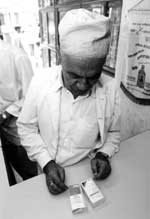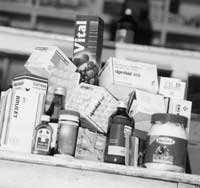 Two things are likely to happen to consumers of pharmaceutical drugs in Nepal: over-prescription and under-consumption. How and when this happens usually depends on more than the just the health of your body and wallet. The availability and marketability of drugs have a greater role to play in our lives than we could have imagined.
Two things are likely to happen to consumers of pharmaceutical drugs in Nepal: over-prescription and under-consumption. How and when this happens usually depends on more than the just the health of your body and wallet. The availability and marketability of drugs have a greater role to play in our lives than we could have imagined.
Hard statistics are difficult to come by when looking into the unwarranted prescription of pharmaceutical drugs, but public health workers say the practice has reached almost epidemic proportions in Nepal. The main actors in the wellness game-doctors, manufacturer and traders, and drug administrators-all are equally to blame for over-medicating unsuspecting consumers. But because of inadequate laws, poor monitoring mechanisms and unconcern on the part of the Department of Drug Administration, no part of the drug-triangle is forced to watch where it's going. "It is this lopsided power relation that puts consumers at disadvantaged position while giving immense power to prescribers," said Sharad Onta, a public health expert with the Public Health Concern Trust (PHECT).
Nepali consumer rights protection laws are feeble and consumer rights campaigning is still in its infancy. Only a few cases are filed against medical practitioners for negligence. And even this only happens when the mistake is of a very large magnitude and attracts the attention and support of activists. More often than not, such lawsuits are most strongly opposed by the very agencies that are meant to ensure medical practitioners follow their code of ethics.
TOO LITTLE
The problem begins with public sector health care institutions, which are basically victims of government ineptitude. Here, people suffer as a result of inadequate supplies, poor infrastructure and health workers who only half the law. Village-based health workers are a neglected lot-they are denied opportunities to upgrade their skills and initiatives to improve their service, which means they have little incentive to put even the skills they have to the best possible use. But the ultimate sufferer in these places is the person who is unwell-their ailments are not properly diagnosed, and they are often provided medication that is past its expiry date, was of poor quality in the first place or has actually lost much of its potency due to inaccurate storage and transportation methods.  Or, there may simply not be enough medication to treat patients effectively, especially at health units in remote places. Study tours to such health posts often find that patients are prescribed doses lower than that recommended because they are also under tremendous pressure to manage the inadequate drug supplies with no help from government outlets.
Or, there may simply not be enough medication to treat patients effectively, especially at health units in remote places. Study tours to such health posts often find that patients are prescribed doses lower than that recommended because they are also under tremendous pressure to manage the inadequate drug supplies with no help from government outlets.
These peripheral health workers are also not protected by laws against "inevitable medical accidents." The international medical code protects health workers from the \'accidental' reaction to penicillin G and V group injection, which could cause death. Health workers in Nepal are not given legal protection against this and the government does not provide a substitute for the antibiotic. Fearing adverse reactions to the drug, many health posts refuse to disperse penicillin, listed as an essential drug, even when they have it in stock. What they do not know is that the occurrence of death as a result of an allergy to penicillin is one in 500,000 and a health worker administrating the drug is not subjected to legal punishment unless wrong intention is proved. Just two years ago, a health assistant from Charikot was imprisoned because he had administered penicillin to a patient who suffered anaphylactic shock as a result and died.
TOO MUCH
The health service private sector suffers from the opposite malady-over-prescription of medicine and over-use of other health facilities. Medical professionals and patients alike don't understand the different roles of nursing, diagnostic, medical and pharmaceutical services too well, and even relatively minor illnesses impose a heavy economic burden on patients and their families through unnecessary tests and medication.
The Nepali market is flooded with approximately 11,000 brands of 35 national and 700 international pharmaceutical manufacturers-which when compared with the population puts Nepal at the top of the heap when it comes to per capita brand consumption. For instance, almost all prescriptions handed out here include a multivitamin tonic, which developed countries advise against, saying such tonics do virtually nothing to enchance the health of people and so is an unnecessary economic burden to the patients. Over-prescription has more dangerous consequences too-practitioners have found that antibiotics are ineffective to treat sexually transmitted diseases (STDs) among Nepali adults due to unscientific use and over-use throughout the average urban Nepali's life. The Ministry of Health has decided to fight fire with fire-every new STD patient is now prescribed a new, potent kind of antibiotic that assumes the patient has already taken at least one course of a similar medicine without consulting a specialist.
Developed countries like the United Kingdom have laws that prohibit manufacturers from investing more than 11 percent of their production costs in advertising. But, in India, the main supplier of pharmaceutical drugs in Nepal, some manufacturers spend up to 36 percent to advertise their wares. This high investment in promotion has accelerated a drive to create "brand loyalty" among medical practitioners-just like you would with shampoo or noodles. This is certainly profitable for manufacturers and traders and even the prescribers, sometimes has the effect of nudging medical practitioners to put self-interest before the well-being of their patients.  Another factor which fuels mis-prescription is the ambiguity in who is allowed to prescribe drugs in the first place. On one hand the government seems to recognise health workers of all levels in all different types of health care units as eligible prescribers. The Nepal Medical Council (NMC) on the other hand only recognises people with the qualification of MBBS and higher as eligible prescribers. The recently registered Health Workers Council has been demanding that health assistants and auxiliary health workers also be given the status by the NMC. The National Drug Policy was enacted in 1995, but that too was silent on who is allowed to be a prescriber, allowing more unqualified people take advantage of the confusion. People with as limited education as a two-week training in pharmacy management are acting as prescribers in community drug stores. And since the dispensing of pills and injections is considered a sign of competence, doctors, pharmacists and unqualified quacks alike prescribe copious quantities of drugs. An urban legend has it that Nepalis, with their propensity for drug-taking, have the most expensive urine in the world, packed as it is with antibiotics.
Another factor which fuels mis-prescription is the ambiguity in who is allowed to prescribe drugs in the first place. On one hand the government seems to recognise health workers of all levels in all different types of health care units as eligible prescribers. The Nepal Medical Council (NMC) on the other hand only recognises people with the qualification of MBBS and higher as eligible prescribers. The recently registered Health Workers Council has been demanding that health assistants and auxiliary health workers also be given the status by the NMC. The National Drug Policy was enacted in 1995, but that too was silent on who is allowed to be a prescriber, allowing more unqualified people take advantage of the confusion. People with as limited education as a two-week training in pharmacy management are acting as prescribers in community drug stores. And since the dispensing of pills and injections is considered a sign of competence, doctors, pharmacists and unqualified quacks alike prescribe copious quantities of drugs. An urban legend has it that Nepalis, with their propensity for drug-taking, have the most expensive urine in the world, packed as it is with antibiotics.
"As many as 90 percent of the people in charge of dispensing medication cannot read the labels attached to packets," says Balkrishna Khakurel of the Department of Drug Administration (DDA) and president of the Nepal Pharmaceutical Association. The management of our drug regimens verges on the criminal sometimes-qualified people often "rent" their certificates for a monthly fee to pharmacies that want to woo patients.
ALL ABOUT CASH
In the absence of regulatory bodies that oversee prescription drugs, fly-by-night pharmaceutical units are coming up because the Nepali people will take, quite literally, anything, and every ailment-no matter how minor-is deemed to require medication. Drug manufacturers and traders engage in cut-throat competition to make profits. The inefficiency of the DDA and the Royal Drug Laboratory in monitoring drug quality and their lack of trained manpower mean that manufacturers and traders can cut costs every which way. Pharmaceuticals are hot business now-manufacturers and traders can make as much as a 60 percent profit on some drugs. The profit margin maintained by pharmaceutical outlets regularly breaches the ceiling fixed by the DDA, which allows only 16 percent profit for retailers, 10 percent for wholesalers and six percent for importers. Traders themselves admit quite frankly that they have a 110 percent margin on the sale of substandard and fake medicine.
Up to 15 percent of the medicines on sale in Kathmandu are estimated to be substandard. Last year the government issued a notice to national drug producers to acquire a Good Manufacturing Practices (GMP) certificate within three years to be allowed to put their products on the market. However, no such requirement is imposed on international manufacturers, who have 83 percent of the medicine market in Nepal.
Most of this is avoidable-we could take a cue from Bangladesh's Minimum Drug List, which listed some 100 basic drugs. Until multinationals got into the game, these were produced in the country in optimum amounts, they were of good quality, generic and cheap. The result was a tremendous improvement in Bangladesh's health system.
Khakurel sums up the situation in Nepal: "We are victims of a systematic irrationality in drugs use."


